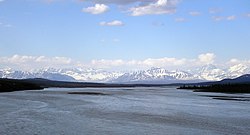This is an old revision of this page, as edited by LeheckaG (talk | contribs) at 18:49, 31 March 2008. The present address (URL) is a permanent link to this revision, which may differ significantly from the current revision.
Revision as of 18:49, 31 March 2008 by LeheckaG (talk | contribs)(diff) ← Previous revision | Latest revision (diff) | Newer revision → (diff) River| Susitna River | |
|---|---|
 | |
| Physical characteristics | |
| Mouth | Cook Inlet of Pacific Ocean |
| • elevation | Template:Unit ft |
| Length | 300 miles (480 km) |
The Susitna River (Template:PronEng) (Dena'ina susitnu, literally 'sand river') is a 300-mile-long (489 km) river in the southcentral region of the U.S. state of Alaska. It, along with the Matanuska River, drains the broad Matanuska-Susitna Valley south of the Alaska Range.
It rises in the Susitna Glacier on Mount Hayes in the Alaska Range near 63°30′N 147°15′W / 63.500°N 147.250°W / 63.500; -147.250. It flows in winding course generally southwest to Curry, then south, along the west side of the Talkeetna Mountains, past Talkeetna, Chulitna River, and Susitna, and drains into Cook Inlet approximately 25 mi (40 km) west of Anchorage.
It receives the Yentna River from the northwest approximately 5 mi (8 km) north of Susitna. It is navigable to 85 mi (137 km) upstream from its mouth to Talkeetna.
The Susitna River is one of Southcentral Alaska's premier sport fishing streams, with significant runs of Chinook and Coho salmon, along with resident grayling, burbot, and rainbow trout. Located within a roadless area, access to the river is difficult and is made usually by power boat from the Susitna River or by floatplane.
Matanuska-Susitna Borough owns much of the land along the Susitna river along with the Deshka River. The impacts of Summer recreational use and tourists have caused loss of riparian vegetation and bank erosion along the Deshka River's lower reaches, which has been partially remedied through a restoration project in the Summer of 2002. However, the borough currently lacks either regulations to prevent further damage or the means to enforce such regulations.
Etymology
The Susitna River stretches from the Susitna Glacier to Cook Inlet. "Susitna" River, named by the Tanaina Indians, means "sandy river". The Susitna River appears to have been first explored in 1834 by a Creole Indian named Malakor. The 1890 census reported that Susitna Village on the east bank of the Susitna River had 146 Kenai Indians and 27 houses.
Location
(1329) Big Susitna River is on the North side of Cook Inlet 22 miles North-East of North Foreland. Mount Susitna, a prominent landmark along the upper part of the inlet, is about 6 miles West of the big Susitna River at a point 13 miles above the mouth.
(1330) The channels across the flats at the mouth of big Susitna River have depths of 2 feet or less at low water and change during the Winter and Spring because of ice and freshet action. The channels above the mouth are said to change frequently in the Spring and early Summer.
(1331) Launches navigate big Susitna River to Yentna River, about 20 miles above Cook Inlet, thence run occasionally up the Yentna River to the forks about 65 miles from the big Susitna River. The tides are not felt more than 7 miles from the inlet, and above this the current is swift. Overhead power cables with a least clearance of 37 feet cross the big Susitna River about 5 miles above its mouth.
(1332) Alexander, Alaska is a small settlement on the West side of big Susitna River 10 miles above the mouth. Susitna, Alaska is on the East side 18 miles above the mouth and just below the mouth of the Yentna River; launches run to and from Anchorage, Alaska. Mail is delivered to both settlements twice monthly by airplane from Anchorage, Alaska.
(1333) Susitna Flats lies between big Susitna River and Little Susitna River and to the East of the latter.
Susitna Flats Light (61°15'10"N., 150°29'17"W.), 19 feet (5.8 m) above the water, is shown from a skeleton tower and is equipped with a racon.
(1334) Little Susitna River, 9 miles West of Point MacKenzie, is said to be navigable for landing craft and skiffs at high water for about 8 miles.
(1335) Caution: the depths offshore and in the approach to Little Susitna River are subject to drastic and continual change.
Ice
Between October 19th. and November 14th., the big Susitna River ices or freezes over for the Winter.
Between April 12th. and May 10th., the ice breaks-up for the Summer.
References
- ^ "Coast Pilot (R) Volume 9, Chapter 4, Pages: 124,224 - Susitna River nautical chart narrative" (PDF). NOAA.
- ^ "Technical Report on Cook Inlet Marine Ice - including the big Susitna River]" (PDF). USACE.
External links
- "Cook Inlet - Northern part 1:194,154 nautical chart 16660". NOAA.
- "Cook Inlet-Approaches to Anchorage, Alaska; 1:50,000 nautical chart 16665". NOAA.
- "Cook Inlet-East Foreland to Anchorage, Alaska; North Foreland 1:100,000 nautical chart 16663". NOAA.
- "Matanuska-Susitna, Wasilla & Palmer Area History". Agate Inn.